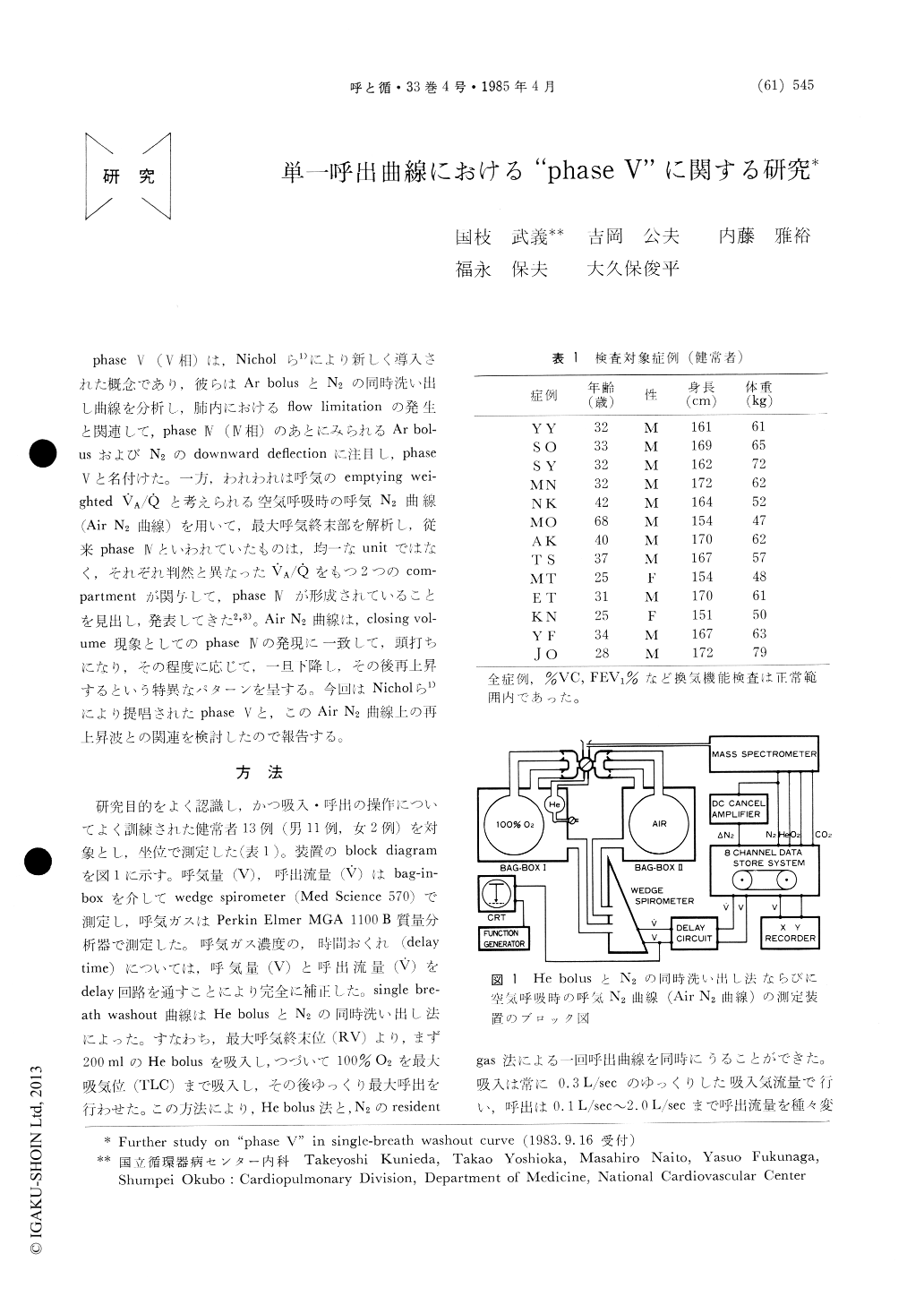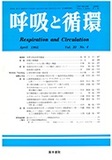Japanese
English
- 有料閲覧
- Abstract 文献概要
- 1ページ目 Look Inside
- サイト内被引用 Cited by
phase V(V相)は,Nicholら1)により新しく導入された概念であり,彼らはAr bolusとN2の同時洗い出し曲線を分析し,肺内におけるflow limitationの発生と関連して,phase IV(IV相)のあとにみられるAr bol—usおよびN2のdownward deflectionに注目し,phaseVと名付けた。一方,われわれは呼気のemptying wei—ghted VA/Qと考えられる空気呼吸時の呼気N2曲線(Air N2曲線)を用いて,最大呼気終末部を解析し,従来phase IVといわれていたものは,均一なunitではなく,それぞれ判然と異なったVA/Qをもつ2つのcom—partmentが関与して,phase IVが形成されていることを見出し,発表してきた2,3)。Air N2曲線は,closing vol—ume現象としてのphase IVの発現に一致して,頭打ちになり,その程度に応じて,一旦下降し,その後再上昇するという特異なパターンを呈する。今回はNicholら1)により提唱されたphase Vと,このAir N2曲線上の再上昇波との関連を検討したので報告する。
A downward deflection following phase IV in single-breath washout test was first termed phase V by Nicho et al., indicating the onset of whole-lung flow limitation. On the other hand, we have independently repelled to find the dramatic changes corresponding to phase IV and phase V on expiratory nitrogen curve in room air breathing "Air N2 Curve". Special device for N2 output of mass spectrometer (Perkin Elmer MGA1100B) was made using DC cancellation amplifier with inspired N2concentration (FIN2) suppressed to zero voltage and only changing fraction (FEN2-FIN2) of expired N2 concentration (EEN2) was magnified by high fidelity DC amplifier. This FAir N2(=FEN2-FIN2) versus expired volume (VE) was designated "Air N2 Curve" with prominent cardiogenic ripples on its ascending plateau in normal subjects. Phase V was studied in 13 healthy normal subjects using simultaneous washout N2 and tracer boluses of He combined with Air N2 curve at different flow rate of 0.1 L/sec to 2.0 L/sec. Alterations of terminal portion near RV of Air N2 curve did not make any difference between expiration from TLC to RV and that from resting tidal breaths to RV without preceding inspiration to TLC. So latter procedure was utilized to analyze terminal changes of Air N2 curve because of reasonably better reproducibility. Air N2 curve showing gradual increase on its plateau was characterized by transient fall followedby abrupt terminal rise near RV in maximal expiration. When expiratory flow rate was increased, level of lung volume above RV indicating transient fall and terminal rise became increased accordingly. At the point where Air N2 curve ceased to increase its N2 concentration phase IV appeared and onset of phase V coincided with appearance of abrupt terminal rise of Air N2 curve. Phase IV and phase V proved to be flow dependent. Mean alveolar N2 concentration was known to be determined by VA/Q of alveoli. Expired N2 concentration was considered by represent integrated VA/Q abnormality weighed by compartmental emptying pattern. It was clear from the current study on Air N2 curve near RV that phase IV resulted from contribution of high VA/Q compartment and that phase V to the contrary was produced by the contribution of low VA/Q compartment.

Copyright © 1985, Igaku-Shoin Ltd. All rights reserved.


